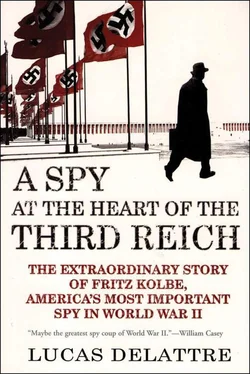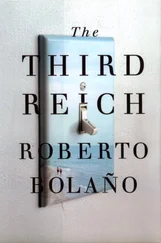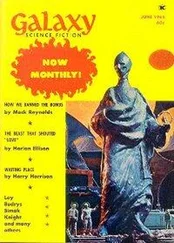To please Fritz and thank him for his help, the Americans answered in a code that he had himself devised. They sent to Berlin a postcard with a mountain scene, mailed from the ski resort of Parsenn, near Davos. The message was the following: “I managed to make three ski jumps. As you know, I am not a beginner. The weather is fine.” The “three successful jumps” meant that the Americans had in fact received the last three letters from Fritz. “I am not a beginner” meant that they had managed to decipher his postcard of February 22. “The weather is fine”: the information was useful. This was the best postcard Fritz had ever received.
10
ONE MISUNDERSTANDING AFTER ANOTHER
Washington, January–March 1944
Although President Roosevelt had received in January 1944 some of the cables sent by Fritz, the Berlin spy continued to be subject to strong suspicion in American intelligence circles. “All the messages are probably authentic…. Although our investigation reveals no evidence to substantiate the suspicion, colleagues here still suspect that the whole thing may be a buildup to a sensational plant,” was still the finding of the experts of the Secret Intelligence department of the OSS on January 22, 1944. If this way of seeing persisted so long in Washington, this was because the Allies themselves frequently used subterfuge and deception in their war against Germany.
On January 28, 1944, OSS headquarters in Washington decided to test the knowledge of the mysterious Berlin agent. It sent to its Bern office a strange message in the form of a guessing game. “What are the present relations between Himmler and Ribbentrop?… Is political intelligence collected by Himmler’s outfit? If so, what agencies are instrumental in collecting it?… Are the intelligence functions of the Auswärtiges Amt and the Sicherheitsdienst coordinated?… What distinction can be made between the Geheimstaatspolizei and the Sicherheitsdienst?… Please try to get Wood to reply to these questions the next chance you get. They are preliminary test queries to which we know the answers.”
Allen Dulles paid no attention to this odd questionnaire and immediately threw the grotesque document into the wastebasket. He was gradually growing weary of all this suspicion and was impatient with the skepticism of his Washington colleagues, but minds barely changed at OSS headquarters; on the contrary, obstacles to the dissemination of Fritz Kolbe’s material proliferated. As time went on, the agency headed by General Donovan became an increasingly less flexible organization, and espionage experts expanded their power, sometimes bureaucratic and nitpicking, over most ongoing operations. Beginning in late 1943, the OSS systematically asked for the opinion of the Military Intelligence Service before authorizing the dissemination of the Kappa/Boston papers to Washington decision makers. And the professionals of military intelligence were even more circumspect than their OSS colleagues. They turned the file over to the Special Branch, the department specializing in deciphering enemy messages, under the authority of Colonel Alfred McCormack, a former Chicago lawyer. Colonel McCormack’s men had the means to cross-check huge quantities of German communications intercepted around the world and had privileged access to the very valuable information gleaned by the British from the “Ultra” system. For several months, Colonel McCormack and his assistants worked with the seriousness and precision of entomologists on the Kappa material. They read and reread, paragraph by paragraph, all the cables given to them by the OSS. Hundreds of documents were studied and dissected. As a result, the dissemination of the documents was considerably slowed.
Beginning in February 1944, “Wood’s” information no longer circulated beyond a very closed circle, limited to the world of intelligence and counterespionage. President Roosevelt stopped being informed of the content of the Boston reports. Among political appointees, only Assistant Secretary of State Adolf Berle remained on the list of recipients. Berle was a brilliant economist close to Roosevelt, charged with coordinating all the “special files,” but he was primarily concerned with the problems of Latin America. It may be asked justifiably whether he was in the best position to grasp the content of the material supplied by Kolbe.
By searching hard enough for a flaw in the “George Wood” documents, Colonel McCormack finally found one. “It’s a bad fish,” he said on reading a German diplomatic cable from Rome, received in Bern in late February 1944. This document mentioned a decree of Marshal Kesselring, commander-in-chief of all Wehrmacht forces in southwestern Europe. The text was as follows: “The Commanding Officer of the Southwest front has decreed that in the event of the evacuation of Rome, all the electric plants with the exception of those supplying Vatican City, all railroad and industrial plants outside of the city, all bridges over the Tiber, and gas and water tubes attached to 5 of these bridges, are to be demolished. The order does not exclude any bridge.” On reading this cable, Alfred McCormack immediately thought that it was a fake. He believed that the Germans had every interest in getting this kind of information to the Allies in order to slow down their offensive in the ongoing Italian campaign. He observed that other elements of information coming from Italy contradicted the tenor of this message. Finally, he judged that Marshal Kesselring did not have the authority necessary to make a decision with such weighty consequences. The order of destruction (even partial) of a city like Rome should logically come from the führer and from him alone. The British, questioned by McCormack, also found the message suspect.
As a consequence, for many more months, everything that came from “George Wood” was read with redoubled caution. In Washington and London, people always anticipated a trap. An OSS procedural notice dated March 24, 1944 said that the reports (except those of counterintelligence import) were to be “disseminated with the explanation that they are unconfirmed and that we are desirous of comment on their authenticity.” At the same time, however, Washington sent a request to Allen Dulles: could his source not provide elements of information about Japan and the Far East?
Washington’s request was a call for help. Throughout the duration of the war, the American espionage network in Asia remained very weak. There was no equivalent to Fritz Kolbe in Tokyo, and Washington did not have a mole in the upper reaches of the Japanese administration. Allen Dulles was probably pleased to note that they were appealing to him, the man in Bern, to collect data from around the world. But how could he transmit the request to Fritz Kolbe in Berlin? He decided to send him a message on a postcard. A classic mountain scene would once again serve the purpose. The signature was a woman’s. The message in German on the reverse was innocuous enough not to arouse the suspicion of the censors, stating that one of her friends prior to the war had kept a shop selling Japanese trinkets, toys, etc., and had found a considerable market for them. Now her friend could get them no more. In view of Germany’s close alliance with Japan, was it possible to find any of this Japanese material in Germany, or to get it through Germany? Her friend wanted more of it. When he received this card mailed from Zurich, Fritz immediately understood what was involved and he began to assemble cables coming from Tokyo. He carefully stored them in his safe for transmission to Bern when the opportunity arose.
Berlin, March 1944
The scene took place in or around March 1944. We are not sure whether Fritz was at home that afternoon or in Maria Fritsch’s apartment in the Charité hospital, his favorite refuge. In any event, he was not at the ministry. His colleagues had seen him at work between eight and noon, as they did every morning, but he had left his office at lunch, pleading a minor illness in order to get permission to leave for a few hours. He had taken with him in his briefcase a confidential memorandum on Hungary that he intended to summarize for the Americans. The document had been prepared by Heinrich Himmler’s services. It was a detailed presentation of the anti-German activities of Miklós Kállay, the prime minister of Hungary. The Reichsführer SS had sent the file to Ribbentrop. As a matter of course, the envelope (stamped geheime Reichssache ) had found its way to Karl Ritter, who had turned it over to Fritz Kolbe for filing. This was not the first time that Fritz had dared to risk taking documents from Wilhelmstrasse. Working at home or at Maria’s, he could concentrate better on reviewing important documents. Of course, this was strictly forbidden. If he had been found outside the ministry in possession of secret files, he would immediately have been turned over to the Gestapo. But no one ever checked the contents of his briefcase.
Читать дальше











